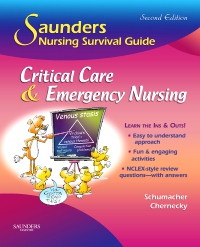
Saunders Nursing Survival Guide: Critical Care & Emergency Nursing, 2nd Edition
Paperback

Part of the popular Saunders Nursing Survival Guide series, this book prepares your students to manage the most common health care problems they'll see in critical care, trauma, or emergency settings. Each chapter is organized from the most immediate and life-threatening conditions to less emergent critical care conditions. Its lighthearted, cartoon-filled approach simplifies difficult concepts, covering each body system in terms of current practice standards.
-
- What You Will Learn learning objectives help your students identify quickly the content covered and goals for each chapter.
- NCLEX examination-style review questions at the end of each chapter allow your students to test their understanding of content and practice for the Boards.
- Cartoon characters with brief captions help to better explain difficult concepts.
- Margin notes are streamlined for ease of use and effectiveness.
- Content updates reflect current practice and emergent situations, including increased focus on disaster preparedness, code management, updated ACLS guidelines, and hypertension.
- Consistent headings break content into four succinct areas of review: What (subject) Is, What You Need to Know, What You Do, and Do You Understand?
- Clinical terms and shorthand expressions are highlighted, exposing your students to terminology used in the hospital setting.
- A color insert illustrates concepts and principles of critical care and emergency nursing, including various complications
- Mnemonic devices aid your students' memories and interactive activities help them learn, with exercises including fill in the blank, matching, word jumbles, true/false, and crossword puzzles.
- Special icons help your students focus on vital information:
- Take Home Points help your students prepare for clinical rotations.
- Caution notes alert your students to dangerous conditions and how to avoid them.
- Lifespan notes point out age-related variations in signs and symptoms, nursing interventions, and patient teaching.
- Culture notes cite possible variations related to a patient's cultural background.
- Web links direct your students to Internet resources for additional research and study.
-
- What You WILL LEARN learning objectives help you identify quickly the content covered and goals for each chapter.
- NCLEX„¥ examination-style review questions at the end of each chapter allow you to test your understanding of content and practice for the Boards.
- Cartoon characters with brief captions help to better explain difficult concepts.
- Margin notes are streamlined for ease of use and effectiveness.
- Content updates reflect current practice and emergent situations, including increased focus on disaster preparedness, code management, updated ACLS guidelines, and hypertension.
-
1. Review of Hemodynamics
2. Shock Trauma
a. Anaphylaxis and Anaphylactic Shock
b. Cardiogenic Shock
c. Hypovolemic Shock
d. Neurogenic Shock
e. Septic Shock
3. Trauma and Emergency Care
a. Rapid Sequence Intubation
b. Increased Intracranial Pressure
c. Traumatic Brain Injury
d. Acute Hemmorrhage/Penetrating Trauma
e. Cardiac Tamponade
f. Hypothermia
g. Near Drowning
h. Overdose
i. Disaster Preparedness
4. Cardiovascular System
a. Angina
b. Acute Coronary Syndrome
c. Heart Failure
5. Respiratory System
a. Non-invasive Ventilation
b. Mechanical Ventilation
c. Pulmonary Embolus
d. Acute Respiratory Distress
6. Nervous System
a. Seizure
b. Status Epilepticus
c. Meningitis
d. Spinal Cord Injuries
e. Spinal Cord Compression
7. Gastrointestinal System
a. Gastrointestinal Bleeding
b. Bowel Obstruction
c. Pancreatitis
d. Liver Failure
8. Renal System
a. Acute Tubular Necrosis
b. Chronic Renal Failure
c. Continuous Renal Replacement Therapy
9. Endocrine System
a. Hyperglycemia
b. Inappropriate Antidiuretic Hormone
c. Diabetes Insipidus
d. Cerebral Salt Wasting
10. Hematolgic System
a. Thrombocytopenia
b. Disseminated Intravascular Coagulation
11. Integumentary System
a. Burns
b. Necrotizing Fascitis
12. Multisystem
a. Code Management (New ACLS Guidelines; Rapid Response Teams)
b. Multiorgan Dysfunction Syndrome


 as described in our
as described in our 